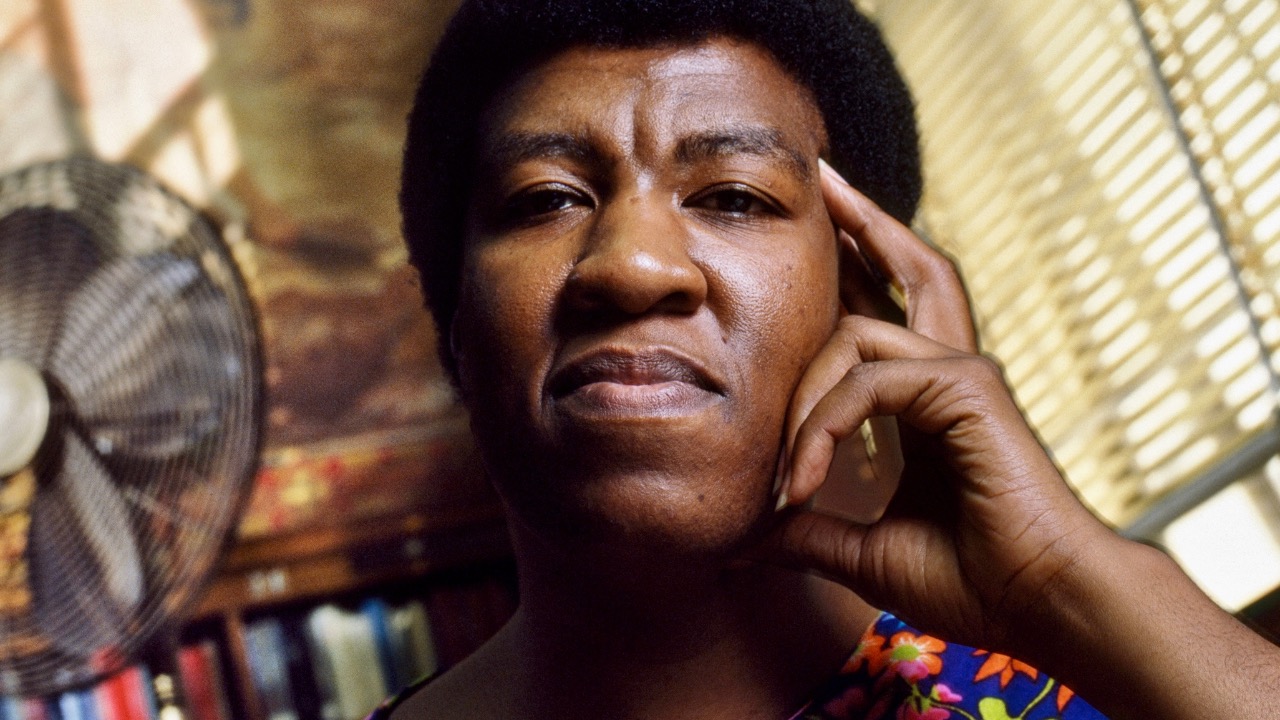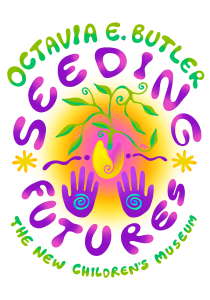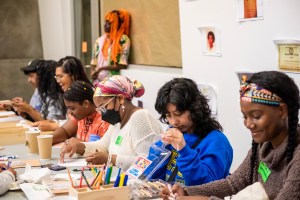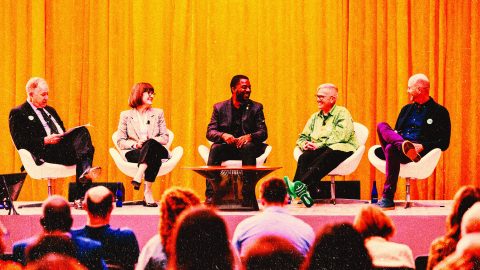
I’m a huge fan of speculative fiction—stories with the power to immerse us in the daily reality of possible futures deeply and viscerally. We can fall in love with fiction in a way we rarely love academic research or formal foresight. As a young adult, I fell in love with the work of Octavia E. Butler, one of the greatest speculative fiction writers of the 20th century. In 1995 she became the first science-fiction writer, and one of the first Black women, to receive a MacArthur “genius” award. Her ground-breaking work explores racial injustice, the climate crisis, gender oppression, inequality and other themes that are only more important today. Her work is receiving renewed attention because one of her most beloved books, The Parable of the Sower, is set in 2024. That story, set in a dystopic future of political fragmentation, global warming, and wealth inequality seems disturbingly prescient. Today on the blog I’m delighted to interview Gabrielle Wyrick and Ayana Jamieson, creators of an exhibit that will share Butler’s work with a new generation of fans and use her life to inspire children to imagine their own futures.
–Elizabeth Merritt, VP of Strategic Foresight and Founding Director, Center for the Future of Museums
Elizabeth Merritt (EM): Gabrielle, can you tell our readers a little bit about yourself and your work?
Gabrielle Wyrick (GW): My name is Gabrielle Wyrick, and I’m the chief curator and director of audience engagement at the New Children’s Museum in San Diego. I’m here today because I am the project lead on the exhibition Octavia E. Butler: Seeding Futures, which opens at the New Children’s Museum in March of 2024. I’m joined here by my colleague, the amazing Dr. Ayana Jamison, who is the advising curator in partnership with the museum on the exhibition.
Ayana Jamieson (AY): Thank you, Gab. I’m also the founder of the Octavia Butler Legacy Network, which was founded in 2011 out of my doctoral research, and I’m an assistant professor of ethnic and women studies at Cal Poly Pomona. Another important thing about me is that I was born and raised in Southern California—the California landscape plays into Butler’s writing, my research, and very heavily into the New Children’s Museum exhibit that we’re working on, bringing together the community and artists.
EM: Awesome, I’m so pleased to meet both of you. Gabrielle, Tell us a little bit about the New Children’s Museum.
GW: We are one of very few children’s museums in the country that is simultaneously a contemporary art space. We really foreground all we do in contemporary art practice and collaboration with contemporary artists across disciplines. That happens through a range of things including immersive exhibitions and commissions, programs, community engagement, and more.
EM: And Ayana, tell us a little bit about the Octavia E. Butler Legacy Network.
AY: We bring together journalists, writers, musicians, physicians, humanitarians, scholars, K-12 teachers, and people with regular jobs—people outside of academia and outside of art and outside of science fiction authorship—to signal boost work inspired by Butler’s work. That encompasses activism, artwork, elementary education, parenting philosophy, and ethnic and women’s studies as we now know it in California. These folks have gathered, both virtually and in person over the last 15 years to uplift Butler’s work even before she became so popular around nine years ago. One of the core principles of the network is community engagement. We leverage the resources from larger institutions or entities and redistribute it for students and other folks making it accessible to working class folks.
One of the things that I love as part of my scholarship is research into Butler’s life and legacy via the archives, her literary papers that she willed to the Huntington Library and Botanical Gardens in San Marino, California. People often use a phrase, “liberate the archives.” I take these very everyday objects that show Butler was a regular person who did regular things, who had a very working-class life.
Our exhibit at the New Children’s Museum is inspired by Butler’s early life, her childhood, and her inspirations that she carried through the rest of her fiction. This is a groundbreaking approach, because most people don’t know that much about her life—they’re only familiar with her published writing and some of her interviews and speeches.
EM: Let’s use that as a jumping off point to talk about the exhibit Octavia E. Butler: Seeding Futures. Can you tell us a bit about your joint goals for the exhibit?

GW: As Ayana mentioned, we certainly want to foster more familiarity of Octavia Butler’s groundbreaking work as a writer and thought leader, but we are most interested in exploring the early life of Octavia Butler as a young person. She had an incredible drive and passion to make a space for herself and her voice in the creative world. She created a place for herself where she didn’t see herself represented, and it’s important to us that youth who experience this exhibition see that as possible.
AJ: One of the things that she said that I really love and admire is, “I wrote myself into the past, present and future.” Butler is not just talking about science fiction; she’s also talking about writing herself into being among a community. She wanted the community to be larger and so she would generously give interviews and teach classes and respond to people’s writing when they gave it to her. Even from childhood she had a working writing group. She’s supposed to be in class, but she starts to talk about her characters. Her imagination was really her core quality as a young child and she maintained that throughout her life. She wanted to be surrounded with people who needed access to the things that she was denied or that didn’t exist yet. So she created them in ways that no one else had done before her. But she also realized there should be more writers doing what she was doing.
EM: In addition to becoming familiar with Butler and her work, are there specific things that you think children will get out of the exhibit?
GW: Absolutely. We are looking at the things that Octavia Butler herself said were formative experiences as a young writer, and we are recreating these experiences in the museum as creative inspiration to young visitors. Our goal is to make this exhibition a space where young Octavias will thrive and see themselves. To do this, we are developing a series of immersive and interactive areas in the exhibition for youth to experience things that Octavia deemed inspirational to her young creative development. There will be four main areas including the public library, the Pasadena City Bus, space, and the Oak Tree. Each section will take Octavia Butler’s own description of the impact of these elements as a grounding, and then each space will be rendered in a magical and fantastical way that allows for the fullest amount of imagination and world dreaming possible.
EM: I read an announcement about the “Seed to Tree” workshops you held last fall for young people 12 and over to inform planning. What kind of input did you get from participants and how is that influencing the exhibit design?
AJ: Even though this is going to open in 2024, this has been in the works for a long time. We were literally talking on the phone, planning our funding application to the NEH, as the pandemic loomed, and I was buying toilet paper at Target. We envisioned a workshop where we would collaborate with community youth, pay them a stipend, and bring them to the museum during the initial planning and then over the duration of the exhibition. We had a huge response—we could only take half of the applicants! So far, these young people, aged 12 and up, have created sculptures, written stories, envisioned what artifacts they would love to have for their community in the future. Some of the artifacts that they created will be integrated into the museum in the exhibit. We plan to bring the workshop participants back on a regular basis to advise us, because they are the thought leaders of the future and the core of what we want this project to embody. Their ideas and their creativity and the things that are important to them, like clean water and solving homelessness and taking care of the earth and being in community, are being integrated into the exhibit. We will bring them back to help us grow and transform the exhibit over the next 2 to 4 years.

EM: One of you was quoted in the press as saying the exhibit will “help young people tell stories of alternative futures that are more fair, just, and hopeful.” Tell me a little bit about that because that’s the kind of quote that inspires me.
GW: In the exhibition itself, we will have a multitude of different ways that young people can express themselves. We’ll have opportunities for them to work with words and stories. They’ll be able to design and make their own landscapes and worlds through a visual art practice. We’ll also have prompting questions that come from Octavia herself interspersed throughout the space, to help children reflect on some of the themes that really resonated with her and in her work.
Beyond the physical exhibition, we are implementing a whole arc of programming and community engagement initiatives that will run alongside the exhibition. In addition to the initial workshop with our youth cohort that’s advising on the exhibition, we will have an ongoing series of Seed to Tree workshops for families, with each workshop exploring a theme, idea, or practice that was important to Octavia Butler. For example, we might have a workshop on indigenous plants. Native plants were very important to Octavia—she references them quite often in Parable of the Sower. We’ll also have public panels, performances, and interdisciplinary activities for people of all ages.
AJ: Right. Like jazz music from the future, and time travel performances within the museum—things that have not been done before, especially with an inter-generational set of patrons. Often older children and middle schoolers get left out of programming in children’s museum settings. It’s more geared toward, you know, the second-grade-and-under set. We want to serve the upper elementary, middle, and high school cohorts with this project, because those were some of the most formative years for Octavia Butler and she consistently writes adolescence as a very important time.
In the museum’s studio and making spaces there will be many opportunities for interactive learning outside of the exhibit itself. We want to integrate the environment and climate change into visual and performing arts making. That’s what I love about this project and why it really thrills me about my own future. When I think about my own adolescence I wonder, what if I had had a base that was this open? An interactive place, not like the kind of museum where everything is behind a rope, you can’t touch anything, and you have to be quiet. Children’s museums are one of the only kinds of places where children are the focus, and adults have to be accounted. It’s really beautiful that that is what will occur.
EM: How can our readers follow each of you, as well as news about the exhibit?
Find us on Instagram and Facebook @thenewchildrensmuseum, and online at thinkplaycreate.org.








